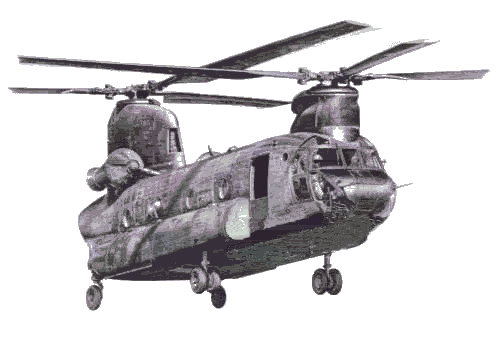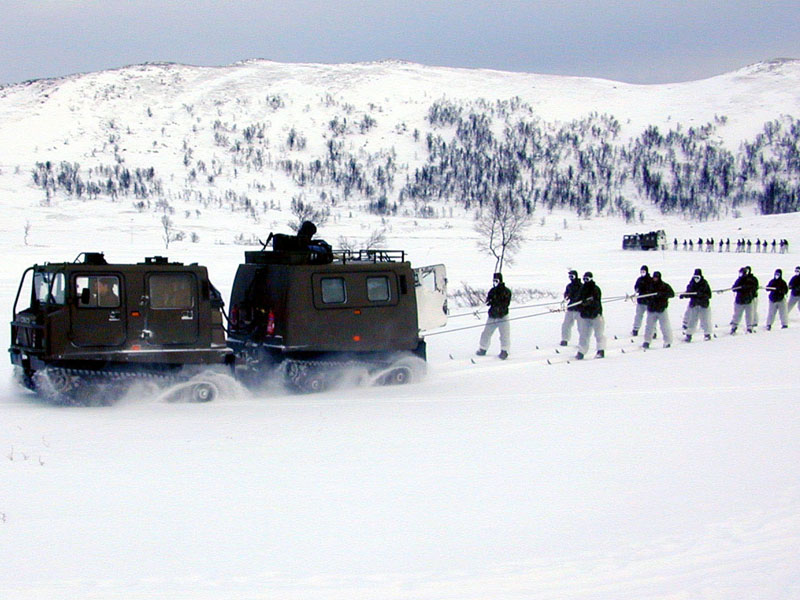



In the the 1999 ARMOR, Dr. Asher II. Sharoni and Lawrence D. Bacon described a conceptual Future Scout and Cavalry System (FSCS) that is a masterpiece of advanced technology. Except for the fact that the Commander and Gunner are located in the hull, the Sharoni/Bacon FSCS has a basically conventional configuration that is approximately as long and wide as an M2A2 Bradley, and weighs 15-20 tons. To enable the scout vehicle to move rapidly about the battlefield a hydro-pneumatic suspension and a hybrid power system would allow cross-country speeds in excess of 60 miles per hour!
Designing a better suspension and increasing the power-to-weight ratio is the usual method for improving mobility. This approach is somewhat lacking, however as the increased speed capability would soon be matched by other armored vehicles. What is needed is a way to achieve a mobility differential that won't be negated by improved suspensions, whether on our own tanks or our enemy's. Like the Horse Cavalry in relation to the foot Soldier the FSCS should be capable of speed differential on the order of fout to one or even greater.! It was just such a mobility differential that enabled Brigadier General John Buford's 1st Cavalry Division to take possession of the high ground at Gettysburg before the slower Confederate infantry, could.
The trouble is there is a practical upper limit to how fast a tracked vehicle L~fl be driven off road and except for flat desert areas like those in Southwest Asia- that limit is t ~i b~lo',s (10 miles per hour In forests m~)unt iiii~ juneles and urb~ terrain the peed itLun able by a oround hu('ein' I SCS ma~ be 110 faster than th ~t ot a ho sC
It should be obs i(Ius tli it the onlv way the FSCS can ha~~ a foul to OriL 5pLLd differential is if it can fl~ This is not to advocate the substitution of helicopters for the FSCS, C\~il thiluCh the~ h~\e bcen successfully employed for scouting for many years. l1(I~C\Ci tlie helicopter's superior mobility would prove invaluable to an FSCS. If the scout vehicle were of a size and weight that permitted it to be transported in the cargo bay of a standard CH-47D, it could be able to move around the battlefield at speeds greater than 140 miles per hour!
Helicopter transport of scout vehicles is not a new concept. Scout HMMWVs and marine corps LAV-Is are often carried by helicopters as underslung loads, but rigging (and derigging) a vechicle for sling-carry takes time, and exposes the personnel, rotorcraft, and vehicle to a number of hazards. These dangers could be minimized if the scout vehicle selected was to be capable of internal transpont by a cargo helicopter. Unfortunately the HMMWV is a little too wide to easily fit into a CH-47, while the other scout vehicle currently in use - the M3 Bradley is much too big and heavy even for sling-carry.
One full-tracked, armored vehicle that can be transported in the Chinook's cargo bay is the Wiesel weapons carrier. In 1994, the German Army formed an air-mobile, light armor battalion that is equipped with TOW and 20mm autocannon variants of the Wiesel. This unit is primarily employed for overwatch mis-sions, counterattacks, and blocking actions, but it can also be used to perform reconnaisance. The Wiesel is likely very well suited to those roles. But it lacks the interal space needed to hold four scouts and their equipment. The mannfacturer has developed a longer and taller version, however, that might prove usable in the scout role. Unfortunately, the increased height of the "stretched" variant dictates that its weapon would have to be removed in order for the vehicle to fit in a CH-47.
Also, none of the Wiesels arc capable of swimming. ,,'hieh definitel' limits their potential as a scout \ehiele One of the FSCS requirements is for a J~i~~1)ilit\, differential relative to both the supported force and enemy units accomplishing this demands not only high speed, but also the ability to swim without preparation. This characteristic was not incorporated into the Sharcinjiltacon FSCS concept, and at a combat weight of 40, 000 pounds, it seems unlikely that a vehicle of the propesed configuration could swim without the aid of a flotation screen - a device that is time-consuming to erect, exposes the crew to possible enemy fire during the assembly pr(ILeduie ~ is too vulnerable to damage during combat operations.
In the brief history of mechanized warfare, the combat use of flotation screens by tanks and infantry vehiclcs has been relatively rare arid has too often resulted in sunken vehicles and drowned crew-men. Because of these factors, the world's armies continue to depend on bridges, ferries and fords to enable their armored forces to cross water obstacles. A scout vehicle that could swim without preparation across bodies of water would have a distinct advantage over an opposing force that lacked that capability. It could for instance use a water obstacle as an aid in breaking contact with a n(ln-s\~'imming (Ipp(Inent. Also. the se(lut \ elude commander would be able to choose almost any point on a river at which to cross, instead of being forced to cross it locations that are sure to be in ilie eneni\" 5 c'uiisic4its.
There is only one tracked, armored vehicle available that has extremely good mobility on all types of terrain, can swim well without preparation, has ample room for a crew of four and a full complement of surveillance equipment, and yet is small enough that it can fit inside of a CH-47. That is the Swedish BV-2O6S, an armored variant of the M973 SUSV currently in service with some units of the U.S. Army.
In its present form, the BV-206S could undoubtedly be an excellent scout vehi-dc, having mobility far superior to both the HMMWV and the M3A2. It is not perfect, though. The armor protection at the body is only comparable to that of the M1114 HMMWV (7.62mm AP and 155mm HE airburst), well below what would be de-sired but it rolls on tracks not air-filled tires. As with the HMMWV, crew vision is provided by windows; such large, flat, elass surfaces tend to be highly reflective and can produce a visual signature that can be easily seen at long distances, though there are anti-reflection products that can fix this.
The BV-206S, like the M973 SUSV, is an articulated vehicle; in essence, it is two tracked vehicles that are mechanically connected. It seems that articulation is necessary for a vehicle that is narrow enough to fit into a CH-47, yet has the requisite mobility and agility. A vehicle with a width of 6.5 feet can be no more than about 13 feet in length, due to technical limitations of tracked vehicles design. A conventional vehicle of these dimensions would be subject to violent pitching when crossing mueb terrain at high speed, making it impossible to keep pace with fast-moving tanks and infantry carriers.
Articulation effectively solves the mobility problem inherent to a narrow vehi-cle, but it causes complications in providing for armament and crew position-ing. The BV-2O6S has a weapon configuration identical to that of the scout HMMWV: a machine gun mounted on the roof of the front vehicle. Not only are these weapons less capable than most scouts would prefer, but it appears that the weapon must be dismounted from the BV-206S in order for the vehicle to have enough vertical clearance when entering or leaving the CH-47. This means that the scouts would be unable to defend against attack while waiting to board the helicopter, and just after offloading.
It does not seem possible to fix these deficiencies without a complete redesign of the vehicle, in order to incorporate a more potent, turret-mounted weapon system. There are three options: install the turret on the front vehicle, the rear vehicle, or both. None of these choices is enurely satisfactory. Putting a two-man turret on the lead vehicle would make it difficult to create room for the driver, and the field-of-fire over the rear arc would be obstructed at times by the trailing vehicle. Placing the turret on the rear vehicle would greatly reduce the space available for surveillance equipment, and the field of ftre over the front arc would be ob-structed at times even by a low-profile front vehicle.
The third alternative is to put a small, one-man turret on both vehicles, so that targets can be engaged at all times, no matter how the front and rear vehicles are oriented.
Self-defense ability: The BV-206S could be substantially upgraded by utilizing the Javelin missile system. Preferably, the Javelin would be on a vehicle mount (similar to what M113 armored personnel carriers in Germany used to have for the Dragon anti-tank missile), but it could also be fired in hand-held mode by a Soldier standing in an open roof hatch.
Due to the above-mentioned characteristics, it is rather unlikely that either the Wiesel or the BV-206S will be FSCS candidates. They do, however, have many desirable and outstanding features that should definitely be incorporated into a state-of-the-art scout vehicle. Whatever configuration is eventually selected for the Future Scout and Cavalry System, for maximum mobility it must be able to swim and to fly!
Bibliography
Bighouse, SGT William, "Scout Vehicles: Still No Good Answer," ARMOR, September-October 1995.
Bolte, BG Philip L., "Full Circle: The Armored Cavalry Platoon", ARMOR, September-October 1994.
Lehner, COL Charles, "Light Enough to Get There, Heavy Enough to Win," ARMOR, July-August 1994.
Mettler, LTC Wolfgang, "The German Airborne Antitank Battalion and the Wiesel Armored Weapon Carrier," INFANTRY January-February 1995.
Sharoni, Dr. Asher H. and Bacon, Lawrence D., "The Future Scout And Cavalry System -(FSCS)," ARMOR, January-February 1999.
Tien, CPT John K., "The Future Scout Vehicle: A DESERT STORM Endorsement", ARMOR March/April 1993
Zumbro, Ralph, "Armored Expeditionary Forces,' ARMOR, September-October 1995.
Stanley Crist is a former scout section leader, having served with the 3rd Battalion, 185th Armor. He has previously been published in ARMOR and other defense-related publications.
FEEDBACK!
E-mail 1st TSG (A) itsg@hotmail.com
The German Army uses Wiesel 1 tracked armored weapon carriers, which are helicopter-deployable, as the core of a light armored battalion. They can be armed with 2Omm autocannons or TOW missile launchers. The limited internal space, however, rules them out as carriers of a four-man scout team with its equipment, but larger Wiesel 2s can carry 4 scouts. Wiesels 1s and Wiesel 2s are not amphibious. - MAK Photo
Scout Vehicle Specifications
General Ml114 Wiesel 2 Bv206S M3A2
Length, overall (inches) 190.5 1488 270.0 258.0
Width, overall (inche~) 86.0 71.7 78.8 129.0
Height, overall (inches) 74.0 87.7 74.8 117.0
Ground clearance (inches) 15.3 11.9 13.8 18.0
Weight, combat loaded (lbs) 12,100 7,900 15,400 60,000
Peformance
Speed (on pavement) 60 mph 45 mph 31 mph 38 mph
Speed (in water) 2.9 mph 4.0 mph
Cruising range 275 miles 370 miTes 230 mites 250 miles
Grade 60 O/o 600/0 100% 60 %
Side slope 40 % 30 % 57 % 40%
Vertical wall climbing N/A l6inches 24inches 36inches
Trench crossing Nil 59 inches 67 inches 100 inches
Internal transport by CH-47D? No Yes Yes No
Swim without preparation? Non-swimmer Non-swimmer Yes No